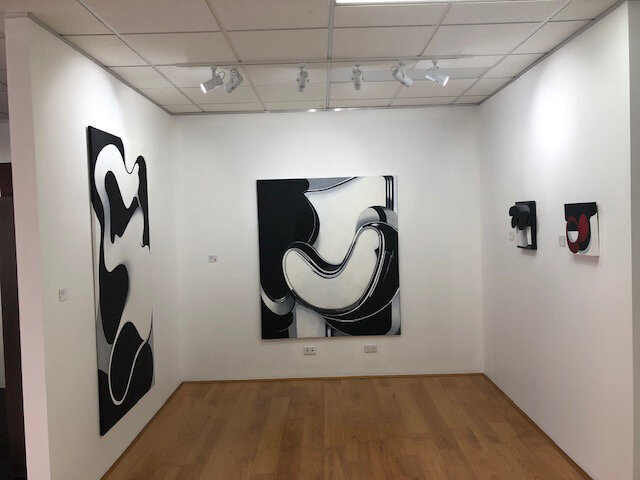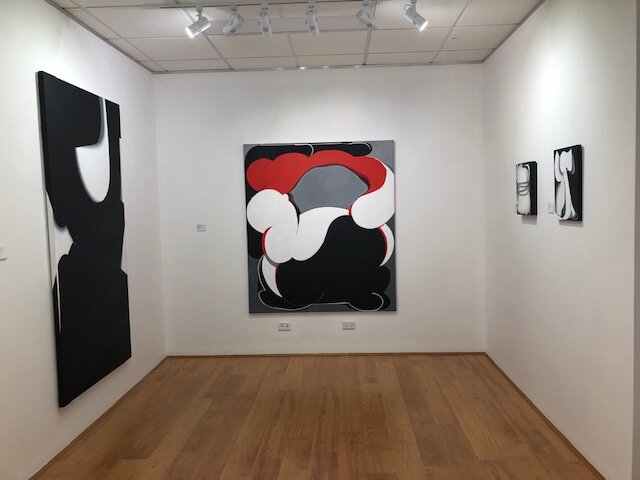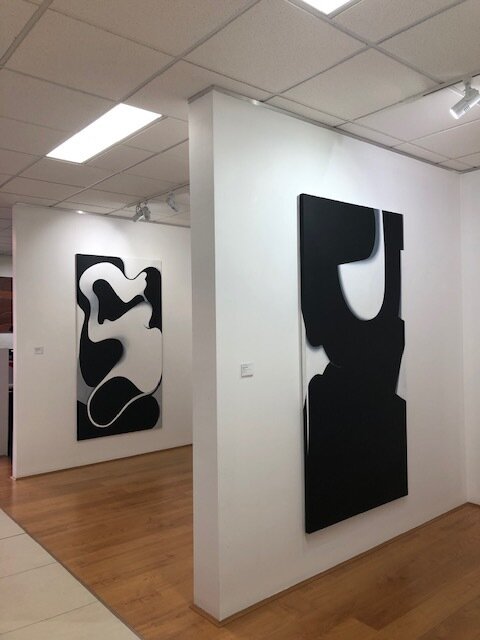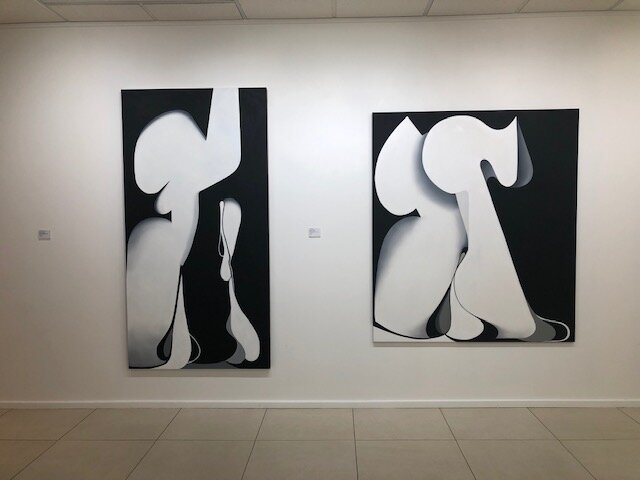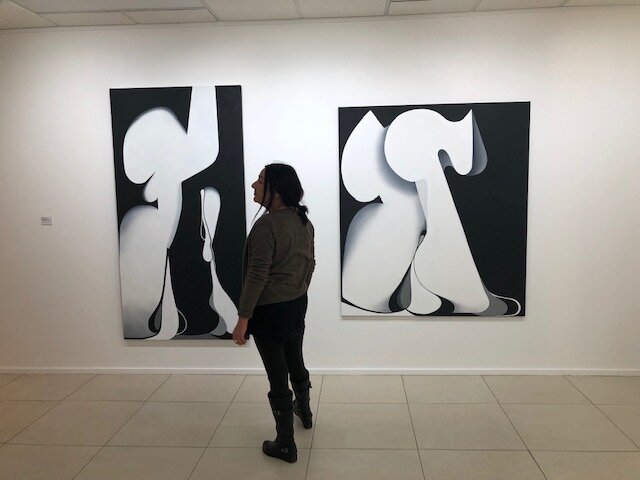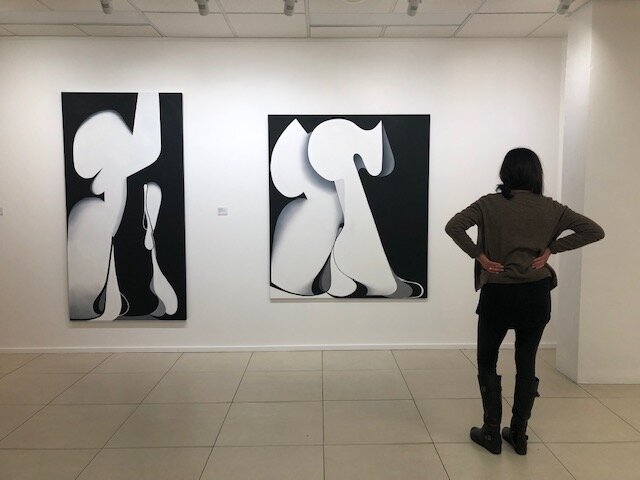Extracts of reviews and writings
‘Marie Hagerty: The Edge’
Gordon Bull
Sometimes paintings, in being looked at, find a way to bind themselves to the one who looks. Snared, the beholder is absorbed, almost lost in the act of looking, while at the same time she is made aware of herself as a perceiving being. Marie Hagerty’s paintings deliver this gift, and command our attention, firstly through her play with the edge. The framing edges as outer limits of the works, yes, but especially the edge of her assured and confident line that slices and divides space, defines bands and blocks of colour, and works to imply cast shadows, and so baffle our perception through unexpectedly conjuring three-dimensional space in works that so strongly emphasise their two-dimensional surface. These paintings are spellbinding.
Line is emphatically edge in Hagerty’s work. The forms in her paintings are brought into being in her studio through and in relation to drawing and collage. Collage as a practice is especially important: her painted edges are often developed along with cut forms and the memory of cut materials and their keen edges haunts the surfaces of her paintings. It is as if the paintings have a double materiality: as if the lines in her work are double edged. Her brush doubles the work of a cutting tool. It is often the illusion of three-dimensionality that is carried by this doubling: the edges often define what appear to be stacked forms or planes. While the broad planes of her forms tend to emphasise the picture plane, the surface of the canvas itself recapitulated, her line as edge virtually cuts that plane to excavate depth. Hagerty’s beguiling edges have a decisive sharpness, and a kind of hardness, while as often curved lines they define what appear to be soft forms. This play of opposites makes them doubly seductive.
Hagerty’s paintings emphasise the surface of the canvas through their broad planes of saturated colour in restricted palettes: luscious blues, purples, or reds, alongside deep blacks, browns, greys, whites and creams. This emphasis on the surface is important because it sets it as a plane of reference against which their usually shallow depth is assessed by the viewer. At first sight Hagerty’s paintings can seem emphatically flat, or at least the viewer is cued by them to expect flatness. Yet some forms appear to stack over or shadow others, and the viewer must refocus to judge the fictive space then produced. Now forms that first appeared fixed can look to fold under the surface, to be lower than the surface of the canvas, or perhaps to swell or pop out from it. What appeared fixed, and still, conjures a kind of action or movement that is typically slight. These are uncanny and very engaging effects. At first subtle, they can become demanding the more the viewer is hooked into looking at them, as if paintings that were silent slowly edge up the volume.
The illusion of depth in Hagerty’s paintings can be confounding: it can be delightful, and it can also tease and frustrate the viewer to want to know more securely where the painting is in space. The paintings sometimes call the viewer to touch them. To touch to verify or refute the presence of depth. At least to hover a hand over a surface to see if it too will cast a shadow where the misty feathered shadows made in paint appear on that surface. This trompe l’oeil effect depends on never being able to be satisfactorily resolved. The viewer might want to stroke the flat surface of a painting, even while they understand that even then the palpable depth they desire would escape them. That frustration is precisely one of the pleasures that the paintings offer. The painted shadows signify the absent depth that they uncannily conjure.
Hagerty has had a long interest in the work of the early twentieth-century modernist avant-garde. Her use of collage as a practice has its roots there, as do some of her forms and compositional strategies. Her work is profoundly related to those now familiar practices. They provide a set of sources that are points of departure for her. It isn’t possible to apply footnotes for Hagerty’s references to modernist art, but viewers familiar with the historical archive may feel the importance of that earlier work for her practice. Her work is not slavishly like Constructivist abstraction, or Surrealist biomorphism, but it couldn’t exist without their precedents.
What drives Hagerty’s paintings most, and what they importune their viewers to feel, is the lived experience of the body in multiple senses. The body is implied in every mechanism that I have described as involving or implicating the viewer in the viewing process, binding the viewer to the paintings. The paintings are thrilling because they enhance the feeling of bodily presence that the viewer experiences while looking at them.
These paintings offer different kinds of invitation depending on their format. Some are quite small works, that immediately call the viewer close-in. Others fill larger and wider frames, sometimes diptychs, that command from a distance and might elicit a slower approach absorbing the viewer in their visual fields. Others take the size and shape that might mirror a torso, and several paintings adopt a tall and relatively narrow frame, like a door. These latter works most directly suggest the size and shape that might admit a body or offer a threshold that a body might pass or enter into.
Hagerty’s paintings imply the sense of bodies in space: in a room, but also in relation to furniture, to clothing as it touches the body, or the body naked. Sometimes an edge strongly suggests a hemline, or a collar, or a cuff, a highly charged transition from veiled to exposed flesh. Sometimes the lines as edges appear like creases in folded flesh, calling up for the viewer the feeling of such folds, or like the edge of flesh enfolded in other flesh. Through vision these works emphasise touch and the feel of one’s body to itself and in relation to other bodies.
The abstract forms in Hagerty’s paintings, through their play with corporeality, thus sometimes suggest actual figures, although these suggestions are oblique and elusive. They depend on the ways in which her forms might be perceived to be located in space, and to imply weight: seated, standing, reclining, suspended; in these attitudes there are references to other, earlier, historical paintings and yet they are fleeting allusions. We might feel the traces of the weight of a body – carried in a Rogier van der Weyden altarpiece, standing in a Velázquez, sunk in the gravity of a Courbet field, or suspended in a Francis Bacon interior. In another instance of teasing the viewer, Hagerty’s forms might imply, but do not deliver, figures, rather her own surrogates.
These paintings, which appear cool and considered, once they have you in their grasp reveal themselves to be hot, and you may find yourself fleetingly feeling like a voyeur, caught, and caught looking. But these paintings do not produce voyeurs. While the rounded, stacked forms in these paintings imply the presence of a body or bodies, they don’t depict bodies as such, but depict (or themselves embody) what it feels like to be in a body. This is most powerfully what the paintings call forth in the viewer in modelling for her embodiment itself. First, surely, what it feels like to be in a female body, as the painter – and first beholder – is female, although gender is at least ambiguous, if not fluid. Sometimes there is a sense of two or more bodies, and perhaps of coupling. Certainly, there is often an active interaction of forms. There is no voyeurism here, as the viewer is implicated in the action itself.
The curved geometries of Marie Hagerty’s works are both still and active. They are both contained and at the same time bursting with energy. Their forms sometimes appear to be concave, sometimes convex, and apparently swelling up and out of the surface of the canvases. Sometimes collaged forms fixed to a surface actually break out of the rectangular framing edges of the paintings, as if affirming their potential to escape those boundaries and enter the space in which the viewer stands. This is the edge, their snare is here: they reach out for you to attend to their finely crafted subtleties.
Gordon Bull
[22 March 2019]
(Gordon Bull is an art historian. He is a former head of the School of Art at the Australian National University, Canberra).

















































